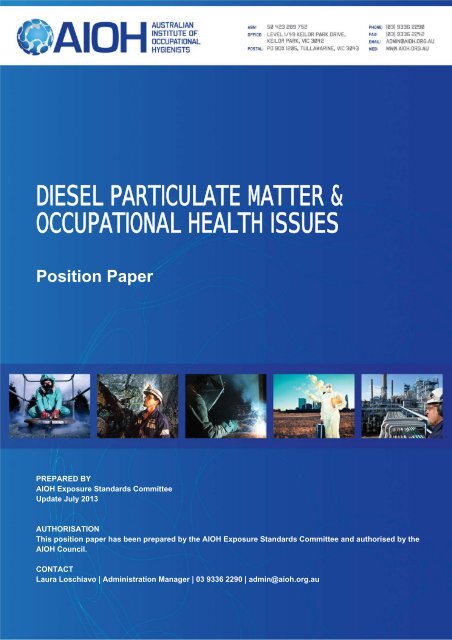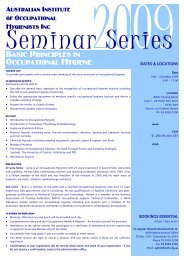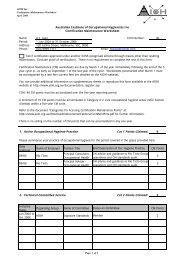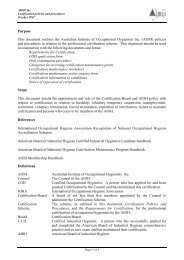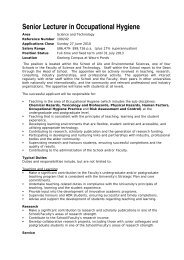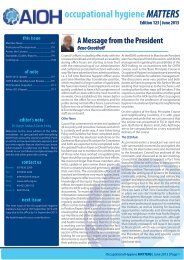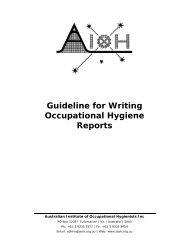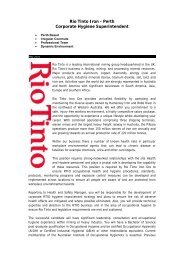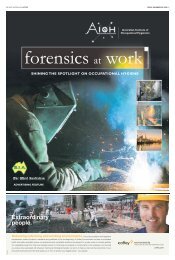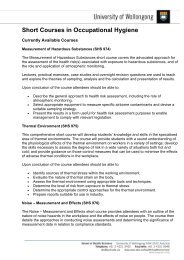diesel particulate matter & occupational health issues - the AIOH
diesel particulate matter & occupational health issues - the AIOH
diesel particulate matter & occupational health issues - the AIOH
Create successful ePaper yourself
Turn your PDF publications into a flip-book with our unique Google optimized e-Paper software.
DIESEL PARTICULATE MATTER &OCCUPATIONAL HEALTH ISSUESPosition PaperPREPARED BY<strong>AIOH</strong> Exposure Standards CommitteeUpdate July 2013AUTHORISATIONThis position paper has been prepared by <strong>the</strong> <strong>AIOH</strong> Exposure Standards Committee and authorised by <strong>the</strong><strong>AIOH</strong> Council.CONTACTLaura Loschiavo | Administration Manager | 03 9336 2290 | admin@aioh.org.au
Table of ContentsAustralian Institute of Occupational Hygienists Inc (<strong>AIOH</strong>)......................................................................................................... 3Thirty Third <strong>AIOH</strong> Council ................................................................................................................................................................ 4List of Abbreviations and Acronyms .............................................................................................................................................. 5<strong>AIOH</strong> Position on Diesel Particulate Matter and its Potential for Occupational Health Issues .............................................. 6Summary ...................................................................................................................................................................................... 6What is Diesel Particulate Matter (DPM)?................................................................................................................................. 7How do we Measure it? .............................................................................................................................................................. 7Hazards Associated with DPM ................................................................................................................................................... 8Major Uses / Potential for Exposure (in Australia) .................................................................................................................. 8Risk of Health Effects................................................................................................................................................................. 10Available Controls ..................................................................................................................................................................... 10Current Applicable Legislation and Standards ...................................................................................................................... 11<strong>AIOH</strong> Recommendation .................................................................................................................................................................11References and Sources of Additional Information ...................................................................................................................11DPM POSITION PAPER PAGE 2 OF 13 I FIRTH | 09.07.2013
Australian Institute of Occupational Hygienists Inc (<strong>AIOH</strong>)The Australian Institute of Occupational Hygienists Inc. (<strong>AIOH</strong>) is <strong>the</strong> association that represents professional<strong>occupational</strong> hygienists in Australia. Occupational hygiene is <strong>the</strong> science and art of anticipation, recognition, evaluationand control of hazards in <strong>the</strong> workplace and <strong>the</strong> environment.Occupational hygienists specialise in <strong>the</strong> assessment and control of:Chemical hazards (including dusts such as silica, carcinogens such as arsenic, fibrous dusts such as asbestos,gases such as chlorine, irritants such as ammonia and organic vapours such as petroleum hydrocarbons);Physical hazards (heat and cold, noise, vibration, ionising radiation, lasers, microwave radiation, radiofrequencyradiation, ultra-violet light, visible light); andBiological hazards (bacteria, endotoxins, fungi, viruses, zoonoses).Therefore <strong>the</strong> <strong>AIOH</strong> has a keen interest in <strong>the</strong> potential for workplace exposures to Diesel Particulate Matter (DPM), asits members are <strong>the</strong> professionals most likely to be asked to identify associated hazards and assess any exposure risks.The Institute was formed in 1979 and incorporated in 1988. An elected governing Council, comprising <strong>the</strong> President,President Elect, Secretary, Treasurer and three Councillors, manages <strong>the</strong> affairs of <strong>the</strong> Institute. The <strong>AIOH</strong> is a memberof <strong>the</strong> International Occupational Hygiene Association (IOHA).The overall objective of <strong>the</strong> Institute is to help ensure that workplace <strong>health</strong> hazards are eliminated or controlled suchthat worker exposures are minimised. It seeks to achieve this by:Promoting <strong>the</strong> profession and principles of <strong>occupational</strong> hygiene in industry, government and <strong>the</strong> generalcommunity.Improving <strong>the</strong> practice of <strong>occupational</strong> hygiene and <strong>the</strong> knowledge, competence and standing of its practitioners.Providing a forum for <strong>the</strong> exchange of <strong>occupational</strong> hygiene information and ideas.Promoting <strong>the</strong> application of <strong>occupational</strong> hygiene principles to improve and maintain a safe and <strong>health</strong>yworking environment for all.Representing <strong>the</strong> profession nationally and internationally.More information is available at our website – http://www.aioh.org.auDPM POSITION PAPER PAGE 3 OF 13 I FIRTH | 09.07.2013
Consultation with <strong>AIOH</strong> Members<strong>AIOH</strong> activities are managed through committees drawn from hygienists nationally. This position paper has beenprepared by <strong>the</strong> Exposure Standards Committee, with comments sought from <strong>AIOH</strong> members generally and activeconsultation with particular members selected for <strong>the</strong>ir known interest and/or expertise in this area. Various <strong>AIOH</strong>members were contributors in <strong>the</strong> development of this position paper. Key contributors included: Brian Davies andAlan Rogers.Thirty Third <strong>AIOH</strong> CouncilPresident:Secretary:Treasurer:President Elect:Councillors:Beno GroothoffDr Julia NorrisGreg OldfieldDr Sue ReedCaroline LangleySamantha ClarkeRussell BondDPM POSITION PAPER PAGE 4 OF 13 I FIRTH | 09.07.2013
List of Abbreviations and AcronymsACES<strong>AIOH</strong>CODEDEEPDNADPMECEPAHEIHSEIARCISBNmg/m 3μmMDGMSHANCINIOSHNSWOH&SPELPM 2.5RECRRR2SIMTARSSMRTWAUKUS / USAWAAdvanced Collaborative Emissions StudyAustralian Institute of Occupational Hygienistscarbon monoxide<strong>diesel</strong> exhaustDiesel Emissions Evaluation ProgramDeoxyribonucleic acid<strong>diesel</strong> <strong>particulate</strong> <strong>matter</strong>elemental carbonEnvironmental Protection Agency (USA)Health Effects InstituteHealth and Safety Executive (United Kingdom)International Agency for Research on CancerInternational Standard Book Numbermilligrams (10-3 grams) per cubic metremicrometer (10-6metres)Mine Design GuideMines Safety and Health Administration (USA)National Cancer InstituteNational Institute for Occupational Safety and HealthNew South WalesOccupational Health & Safetypermissible exposure limit<strong>particulate</strong> <strong>matter</strong> with a diameter of 2.5 micrometres or lessrespirable elemental carbonRelative RiskCoefficient of DeterminationSafety in Mines Testing and Research Stationstandard mortality ratio (observed deaths / expected deaths)time weighted averageUnited KingdomUnited States of AmericaWestern AustraliaDPM POSITION PAPER PAGE 5 OF 13 I FIRTH | 09.07.2013
Summary<strong>AIOH</strong> Position on Diesel Particulate Matter and its Potential forOccupational Health IssuesThis is an update of <strong>the</strong> previous Position Paper on <strong>diesel</strong> <strong>particulate</strong> <strong>matter</strong> (DPM) issued by <strong>the</strong> <strong>AIOH</strong> (2007) andreflects <strong>the</strong> <strong>AIOH</strong> review of <strong>the</strong> recent National Cancer Institute (NCI) epidemiological study and <strong>the</strong> InternationalAgency for Research on Cancer (IARC, 2012) reclassification.Although <strong>the</strong> adverse <strong>health</strong> effects of <strong>the</strong> gaseous fraction of <strong>diesel</strong> emissions have been known for some time, onlyin <strong>the</strong> last two decades has research indicated that <strong>the</strong> <strong>particulate</strong> component (DPM) of <strong>the</strong> <strong>diesel</strong> exhaust has <strong>the</strong>potential to induce various <strong>health</strong> effects. In addition, <strong>diesel</strong> exhaust emissions are known to be associated withnon-<strong>health</strong> aspects such as malodour, visual and nuisance pollution.Methods to monitor workplace exposures to <strong>diesel</strong> <strong>particulate</strong> (capture of <strong>the</strong> submicron aerosol fraction andanalysis as elemental carbon; EC) are now readily available and control technologies have been developed forindustries of known elevated exposure (eg underground mining).Based on some of <strong>the</strong> animal and epidemiological studies, it has been apparent for a number of years that DPM is apotential carcinogen. The recent 2012 IARC classification of DPM as a Group 1 carcinogen (without indicating <strong>the</strong>degree of potency) is simply a continued progression of toxicological and epidemiological information that has beenaccumulating in <strong>the</strong> literature over <strong>the</strong> past 30 years. However, due to information deficiencies in <strong>the</strong> literature,particularly regarding lack of data on past exposure conditions, including <strong>the</strong> multistage surrogate data used in <strong>the</strong>recent 2010 NCI/NIOSH study, <strong>the</strong> <strong>AIOH</strong> has serious concerns as to <strong>the</strong> degree of potency being assigned to <strong>diesel</strong><strong>particulate</strong>s by some regulatory authorities. It is most likely that as with many low potency substances <strong>the</strong> issue maynever be completely defined.There is little doubt that this area of <strong>the</strong> <strong>health</strong> debate will continue for some time within <strong>the</strong> scientific and regulatorycommunity, due in part to limitations in <strong>the</strong> epidemiological studies. Limitations are imposed by <strong>the</strong> requirementsfor suitable large sized study populations necessary to study common cancers such as lung cancer; <strong>the</strong> <strong>issues</strong> indealing with a 30 to 40 year latency; <strong>the</strong> absence of actual exposure data over <strong>the</strong> long latency period; and <strong>the</strong>control of confounders, particularly due to <strong>the</strong> overwhelming effects of tobacco smoking on lung cancer outcome in<strong>the</strong> population. Given <strong>the</strong> difficulties of finding rigorous and statistically valid historical exposure data, particularly inregard to potency, <strong>the</strong> <strong>issues</strong> may never be completely or adequately resolved. The altered chemical emission profilefound with contemporary engines, improved mining ventilation and improved fuels is now quite different to pastDPM exposures upon which <strong>the</strong> epidemiology studies were based.There is an emerging trend within <strong>the</strong> <strong>occupational</strong> hygiene community to take a pragmatic approach to measureand control exposures of <strong>the</strong> noxious, irritant and malodorous emissions without attempting to define a doseresponse based exposure standard.Notwithstanding <strong>the</strong> lack of a defined universal dose response relationship, experience has shown that whenworkplace exposures are controlled below 0.1 mg/m 3 DPM (measured as submicron elemental carbon), irritant effectdecreases markedly. <strong>AIOH</strong> believe that such a level should result in a reduced lung cancer outcome if such acarcinogenic effect is attributable to DPM exposure.In <strong>the</strong> absence of any more definitive data, <strong>the</strong> <strong>AIOH</strong> supports <strong>the</strong> use of an exposure standard of 0.1 mg/m 3 DPM(measured as submicron elemental carbon) as being a balance between <strong>the</strong> factors of primarily minimising irritation,secondarily minimising any potential for risk of lung cancer to a level that is not detectable in a practical sense in <strong>the</strong>work force, and finally on <strong>the</strong> basis of setting a level achievable as best practice by industry and government.DPM POSITION PAPER PAGE 6 OF 13 I FIRTH | 09.07.2013
What is Diesel Particulate Matter (DPM)?Over <strong>the</strong> past 115 years <strong>the</strong> invention of a compression ignition engine by Rudolph Diesel in <strong>the</strong> 1890’s has contributedsignificantly to <strong>the</strong> productivity of many nations, owing to <strong>the</strong> widespread use of larger <strong>diesel</strong> powered equipment inmost industrial activities. The down side in terms of <strong>occupational</strong> <strong>health</strong> has been <strong>the</strong> exposure of a large number ofworkers to <strong>the</strong> complex mixture of toxic gaseous, adsorbed organics and <strong>particulate</strong> components found in <strong>the</strong> rawexhaust emissions.The gaseous phase of <strong>diesel</strong> exhaust consists largely of <strong>the</strong> same gases found in air, such as nitrogen, oxygen, carbondioxide and water vapour.The <strong>particulate</strong> fraction of <strong>the</strong> <strong>diesel</strong> exhaust aerosol consists of a solid carbon phase and ultra-fine droplets of acomplex mix of semi-volatile organic compounds. The solid <strong>particulate</strong> fraction consists mainly of very small particles(typically 15 30 nm diameter) that rapidly agglomerate toge<strong>the</strong>r to form “chains” or clumps of particles, which are<strong>the</strong>mselves typically
Real-time monitoring instruments currently on <strong>the</strong> market can be used as very useful indicative instruments, in helpingidentify DPM sources and manage and reduce DPM levels. However, <strong>the</strong>se need to be adequately calibrated againsttraceable primary standards such as for total carbon (TC) or EC.Hazards Associated with DPMIn 1988 <strong>the</strong> US National Institute of Occupational Safety and Health (NIOSH) published Criteria Bulletin No.50 (NIOSH,1988) which proposed a potential link between <strong>occupational</strong> exposure to <strong>diesel</strong> exhaust and lung cancer. The NIOSHfinding was based on <strong>the</strong> consistency of toxicological studies in rats and mice and limited epidemiological evidence,mainly from railroad workers.The IARC evaluation 2A (probable human carcinogen) was based on limited evidence in humans and sufficient evidenceof carcinogenic risk in animal studies (IARC, 1989).The Health Effects Institute (HEI, 1995) undertook a review of <strong>the</strong> toxicological studies including acute and chroniceffects (such as risk of lung and o<strong>the</strong>r cancers). It also included <strong>the</strong> 30 epidemiological studies of workers exposed to<strong>diesel</strong> emissions in <strong>occupational</strong> settings for <strong>the</strong> period 1950 to 1980. About half of <strong>the</strong>se epidemiological studiesindicated an increase risk of lung cancer and <strong>the</strong> remainder showed no increase in lung cancer risk. HEI after examining<strong>the</strong> positive outcome studies concluded that <strong>the</strong> epidemiological data indicated weak associations between exposure to<strong>diesel</strong> exhaust and lung cancer with a relative risk of 1.2 to 1.5. They issued a note of caution indicating that all of <strong>the</strong>studies lacked definitive exposure data for <strong>the</strong> populations studied and most had an inability to determine <strong>the</strong> influenceof confounding factors, such as tobacco smoking.Mines Safety and Health Administration (MSHA, 2001) reviewed 47 epidemiological studies and determined that in 41studies <strong>the</strong>re was some degree of association between <strong>occupational</strong> exposure to <strong>diesel</strong> <strong>particulate</strong> <strong>matter</strong> and anexcess prevalence of lung cancer. However, some of <strong>the</strong>se studies had limited statistical power ei<strong>the</strong>r because <strong>the</strong>yincluded relatively few workers or had an inadequate allowance for latency or follow up period. MSHA <strong>the</strong>n concluded,based on <strong>the</strong> studies with positive lung cancer outcomes and implied estimates of historical exposure levels, thatexposure at a mean concentration of 0.64 mg/m 3 DPM for a period of 45 years would result in a relative risk of 2.0 forlung cancer.The United States Environmental Protection Agency (US EPA) conducted a <strong>health</strong> assessment for <strong>diesel</strong> engine exhaust(US EPA, 2002). They concluded that acute effects with respect to <strong>health</strong>, such as eye, throat and bronchial irritation,light headedness, nausea, cough and phlegm were evident. With respect to chronic non cancer respiratory effects <strong>the</strong>ysuggested, from animal studies, <strong>the</strong> potential for chronic respiratory disease in humans. The US EPA also concludedthat lung cancer was evident in <strong>occupational</strong>ly exposed groups but could not define sufficient dose response data toproduce a quantitative risk assessment.Based on <strong>the</strong>ir interpretation of <strong>the</strong> toxicological and epidemiological data, regulatory authorities in USA, Europe andCanada have concluded that sufficient evidence exists to indicate that <strong>diesel</strong> <strong>particulate</strong> presents an increased risk oflung cancer, although <strong>the</strong> absolute quantification of potency remains unclear. On <strong>the</strong> o<strong>the</strong>r hand, <strong>the</strong> UK HSE (2012)believes <strong>the</strong>re is limited evidence that an increased risk of cancer is attributable to exposure to <strong>the</strong> <strong>particulate</strong>s found in<strong>diesel</strong> engine exhaust emissions and that although sustained exposure to <strong>diesel</strong> engine exhaust emissions over manyyears may produce cancer, <strong>the</strong>re is insufficient evidence overall for <strong>diesel</strong> engine exhaust emissions to be regarded as"a carcinogenic substance" under UK OH&S legislation. A NSW Coal Industry cancer surveillance study has shown nosignificant cancer risk for underground workers exposed to high levels of <strong>diesel</strong> <strong>particulate</strong> (SMR of 0.85 all cancers, 0.74for lung cancer) (Brown et al., 1997).Previous reviews by US EPA and MSHA had flagged an epidemiological study with a potential dose response componentthat was being conducted by a joint NCI and NIOSH research program. The multi study, published as <strong>the</strong> ‘DieselExhaust in Miners Study’, consisted of a cohort of 12,315 mine workers from eight underground non-metal hardrockmines with DE, operating from 1946 onward (NCI, 2012). Mortality analysis indicated a lung cancer SMR of 1.21 for everundergroundworkers and 1.33 for surface only workers. Using a number of steps and various surrogates of exhaustemission exposure, <strong>the</strong> researchers made estimates of retrospective exposures to respirable elemental carbon (REC –similar to submicron EC) over <strong>the</strong> previous 50 years and were able to produce in <strong>the</strong> mortality and case control analysisDPM POSITION PAPER PAGE 8 OF 13 I FIRTH | 09.07.2013
a dose response trend between cumulative and average intensity of exposure and relative risk (RR) of lung cancer. Theretrospective exposure methodology, which stepwise linked historical carbon monoxide (CO) data, equipment power,ventilation rates and varying mining and haulage methods over time, to contemporary EC exposures, based on log-logtransformations, provided very poor correlation co-efficients that were not statistically significant in each step of <strong>the</strong>analysis (eg CO to REC r 2 =0.17, engine power to CO r 2 =0.01 (NCI, 2010)). While <strong>the</strong> NCI study may provide someevidence of a weak dose response relationship with wide confidence intervals for lung cancer for this specific studygroup, in practice how this relationship applies to o<strong>the</strong>r <strong>occupational</strong> situations and differences in <strong>the</strong> altered chemicalemission profile found with contemporary engines remains unclear at this stage.The NCI study has been subject to a number of criticisms in <strong>the</strong> literature and will be <strong>the</strong> subject of detailed examinationby an independent research board from HEI commencing in 2013.IARC reconvened a working group to review <strong>the</strong> data available on DPM since its 1989 classification. In June 2012 IARCclassified <strong>diesel</strong> <strong>particulate</strong> extract as carcinogenic to humans (Group 1), on <strong>the</strong> basis that on its analysis <strong>the</strong>re was nowsufficient evidence from human and animal studies. A summary of <strong>the</strong> findings indicates <strong>the</strong> basis was mountingconcern due to findings in epidemiological studies across workers exposed in a range of settings and <strong>the</strong> 2012 NCI‘Diesel Exhaust in Miners Study’ re-emphasised evidence on which <strong>the</strong> decision was made (presumably on <strong>the</strong> basis of<strong>the</strong> NCI outcome of a dose response relationship for lung cancer) (IARC, 2012). The detailed review of all data and <strong>the</strong>reasoning for changes in classification is to be included in IARC Monogram #105 due in late 2013.While <strong>the</strong> epidemiological outcomes of cancer associated with exposure to <strong>diesel</strong> <strong>particulate</strong> remains unclear, and isunlikely to be conclusively resolved in <strong>the</strong> near future, <strong>the</strong>re is no doubt as to <strong>the</strong> irritant nature of <strong>diesel</strong> emissions(including <strong>particulate</strong>) in confined atmospheres including that found in mines. On this basis <strong>the</strong> control of suchemissions to minimise irritation in workplaces may in turn reduce <strong>the</strong> potential for any long term <strong>health</strong> effects belowthat which is detectable.The HEI has produced a detailed review of <strong>the</strong> epidemiological studies of non-malignant respiratory disease in groups ofworkers exposed to <strong>diesel</strong> <strong>particulate</strong> emissions. HEI (1995) found that <strong>diesel</strong> exhaust exposures produced chronicchanges in lungs of laboratory animals and this may be a problem if <strong>the</strong> effects were transferable to humans. Inreviewing short-term exposure studies little evidence was found for changes in pulmonary function related to <strong>diesel</strong>exhaust exposure, and it was unclear as to what extent such acute response would indicate <strong>the</strong> potential for chronicrespiratory disease. In long-term exposure studies (six of which addressed effects in miners) some studies suggested aslight decrease in lung function, but overall <strong>the</strong> studies do not provide strong or consistent evidence for chronic, nonmalignantrespiratory effects associated with <strong>occupational</strong> exposure to DPM. In addition HEI found that <strong>the</strong> publishedmortality studies to 1995 do not provide consistent evidence of an effect of <strong>occupational</strong> exposure on mortality fromnon-malignant respiratory disease. Two recent studies funded and published by HEI examined <strong>the</strong> pulmonary effects ofexposure to DPM on non-smoking asthmatic’s (HEI, 2009 & 2012). The studies indicated only minor reductions in lungfunction and airways inflammation indicating little biological response in <strong>the</strong>se lung sensitised individuals. The studiesare in line with those reporting similar effects on workers exposed to break down products from natural polymers, suchas proteins and vegetable oils, occurring in <strong>the</strong> process of cooking some foods.A number of preliminary toxicological studies have been conducted on <strong>diesel</strong> emissions from contemporary post 2007<strong>diesel</strong> engines. The Advanced Collaborative Emissions Study (ACES) animal toxicological study consisted of long term(16 hour a day, 5 days a week for up to 12 months) sub-chronic exposures of <strong>diesel</strong> emissions from a 2007 compliantengine. No genotoxic effects (changes in DNA) were found and only mild inflammatory effects were observed in <strong>the</strong>lungs of <strong>the</strong> rats and mice so exposed (HEI, 2012).Emerging review studies on exposures to ultrafine particles in air pollution studies are tending to indicate that mortalityand morbidity effects are better explained by PM2.5 fraction of aerosols ra<strong>the</strong>r than <strong>the</strong> ultrafine fraction which is lessthan 100 nanometer size (HEI, 2013).DPM POSITION PAPER PAGE 9 OF 13 I FIRTH | 09.07.2013
Major Uses / Potential for Exposure (in Australia)Potential for exposure to DPM exists whenever workers are in close proximity to operating <strong>diesel</strong> equipment. In manycases <strong>the</strong> fact that <strong>the</strong> equipment is operating in <strong>the</strong> open environment significantly reduces <strong>the</strong> potential for excessiveexposures. Exposure assessments conducted aboard <strong>diesel</strong> locomotives have ranged from
Overall an integrated approach specific to each exposure situation is necessary to control DPM worker exposures to <strong>the</strong>recommended exposure limit. The use of real-time monitoring devices that are calibrated against primary standards ofEC or TC, both on persons and on vehicles, can facilitate <strong>the</strong> monitoring, management and reduction of DPM levels.Current Applicable Legislation and StandardsLegislation for <strong>the</strong> control of DPM has been around for a number of years but is still in its early stages of developmentand implementation.On 2 February 2007 <strong>the</strong> NSW Department of Primary Industries issued a gazettal notice which picked up sections of<strong>the</strong>ir Mine Design Guideline (MDG29) and thus also picked up an 8 hour TWA exposure standard of 0.1 mg/m 3 (assubmicron EC) for NSW coal mines on <strong>the</strong> basis that compliance with such a value ‘should provide adequate protectionagainst irritant effects and also minimise any risk of lung cancer’. MDG 29 was later extended to cover o<strong>the</strong>runderground non-coal mining operations (NSW Primary Industries, 2008). Initially considered by some to be merely aguide to good practice, recent amendments to include national uniform OH&S regulations mean that it is nowconsidered as mandatory practice in NSW mining operations.In December 2012 <strong>the</strong> Queensland Mines Inspectorate, after consideration of <strong>the</strong> IARC 2012 classification of <strong>diesel</strong>engine exhaust, issued a Safety Bulletin recommending adoption of <strong>the</strong> MDG29 limit of 0.1 mg/m 3 (measured as submicronEC), shift adjusted (Qld Department of Natural Resources and Mines, 2012).Around <strong>the</strong> same time in Western Australia (WA) <strong>the</strong> Department of Mines and Petroleum issued a Draft Guideline witha recommended exposure limit of 0.1 mg/m 3 (as EC measured as a time weighted average over 8 hours) based on <strong>the</strong>recommendations of <strong>the</strong> <strong>AIOH</strong> (2007) and <strong>the</strong> use of such a value in o<strong>the</strong>r interstate jurisdictions (WA Department ofMines and Petroleum, 2013).Overseas, legislation is currently in place in <strong>the</strong> USA, Canada and Europe to control DPM exposures in mining andtunnelling. Effective January 2007, MSHA in <strong>the</strong> USA reduced <strong>the</strong>ir exposure limit (PEL) in mines to 0.35 mg/m 3 (as totalcarbon, equivalent to 0.31 mg/m 3 as EC). By January 2008, <strong>the</strong> final PEL in mines became 0.16 mg/m 3 (as total carbon,equivalent to 0.12 mg/m 3 as EC). The basis for <strong>the</strong> MSHA standard was in part <strong>the</strong> consideration for potential risk ofexcess lung cancer (MSHA, 2001). Germany has an exposure standard for underground non-coal mines of 0.3 mg/m 3 ,and 0.1 mg/m3 for all o<strong>the</strong>r activities measured as whole <strong>diesel</strong> <strong>particulate</strong>.<strong>AIOH</strong> RecommendationBased on <strong>the</strong> available information, <strong>the</strong> <strong>AIOH</strong> believes that worker exposure to DPM levels should be controlled tobelow 0.1 mg/m 3 as an 8 hour time weighted average value, measured as submicron elemental carbon. The value hasbeen determined as being a balance of <strong>the</strong> factors such as primarily minimising eye and respiratory irritation, <strong>the</strong>nsecondarily minimising any potential for risk of lung cancer to a level that is not detectable in a practical sense in <strong>the</strong>work force, and finally on providing a level that is achievable as best practice by industry and government.DPM POSITION PAPER PAGE 11 OF 13 I FIRTH | 09.07.2013
References and Sources of Additional InformationSpecific references used in <strong>the</strong> production of this position statement include:<strong>AIOH</strong> (2007). Position paper – Diesel Particulate and Occupational Health Issues, May 2007.Brown, AM et al. (1997). The Occurrence of Cancer in a Cohort of New South Wales Coal Miners. Aust & NZ J PublicHealth 21(1) 29-32.Dabill, DW (2004). Controlling and monitoring exposure to <strong>diesel</strong> engine exhaust emissions in non-coal mines. Healthand Safety Laboratory Research Report 252 for <strong>the</strong> UK HSE (see http://www.hse.gov.uk/research/rrpdf/rr252.pdf).Davies, B & A Rogers (2004). A guideline for <strong>the</strong> evaluation and control of <strong>diesel</strong> <strong>particulate</strong> in <strong>the</strong> <strong>occupational</strong>environment. Australian Institute of Occupational Hygienists, Inc PO Box 1205, Tullamarine Victoria 3043 Australia ISBN0 9577703 5 9.Groves, J & JR Cain (2000). A Survey of Exposure to Diesel Engine Exhaust Emission in <strong>the</strong> Workplace. Ann Occup Hyg 44:435-447.Hedges, K, et al, (2007). Diesel Particulate Matter in Underground Mines – Controlling <strong>the</strong> Risk, Proceedings TheAusIMM New Leaders Conference 2-3 May 2007.HEI (1995). Diesel exhaust: a critical analysis of emissions, exposure and <strong>health</strong> effects. A special report of <strong>the</strong>Institute’s Diesel Working Group, April 1995. Cambridge, MA: Health Effects Institute.HEI (2009, 2012 & 2013). A series of Research Reports specific to Diesel Particulate available on www.<strong>health</strong>effects.orgIARC (1989). IARC monograph on <strong>the</strong> evaluation of carcinogenic risk of chemicals to humans: <strong>diesel</strong> and gasoline engineexhaust and some nitroamenes. Vol 46. Lyon, France: International Agency for Research on Cancer.IARC (2012). Press Release #213, Diesel Engine Exhaust Carcinogenic, June 2012.Joint Coal Board (1999). Diesel Particulate in Coal Mines (1st Edition) – Questions & Answers. The Joint Coal Board 1999(Australia, NSW).Liukonen, LR, et al. (2002). Diesel Particulate Matter Exposure to Railroad Train Crews. Am Indust Hygiene Assoc J 63(September/October); 610-616.MSHA (2001). Mine Safety and Health Administration 30 CFR part 57 Diesel Particulate Matter Exposure of UndergroundMetal and Nonmetal Miners; Final Rule, US Federal Register January 19, 5706-912.NCI (2010). Stewart, P, et al. The Diesel Emissions in Miners Study: I Overview of <strong>the</strong> Exposure Assessment Process, AnnOccup Hyg 54:728-746, 2010. Coble, J, et al, II Exposure Monitoring Surveys and Development of Exposure Groups. ibid747-761, 2010. Vermeulen, R, et al, III Interrelationship between Respirable Elemental Carbon and Gaseous andParticulate Components of Diesel Emissions from Area Sampling in Underground non-metal Mining Facilities, ibid 762-773, 2010. Vermeulen, R, et al. IV Estimating Historical Exposures to Diesel Emissions in Underground Non-metal MiningFacilities, ibid 774-778, 2010.NCI (2012): Attfield, et al, The Diesel Emissions in Miners Study: A Cohort Mortality Study with Emphasis on Lung Cancer.J Natl Cancer Inst 104: 2012 and Silverman, et al, The Diesel Exhaust in Miners Study: A Nested Case-control Study of LungCancer and Diesel Exhaust, JNCI 104: 2012.NIOSH (1988). Carcinogenic effects of exposure to <strong>diesel</strong> exhaust. Current Intelligence Bulletin 50, August 1988.NIOSH (2003). Diesel <strong>particulate</strong> <strong>matter</strong> (as elemental carbon) and appendix Q. NIOSH Manual of Analytical Methods,Fourth Edition, NIOSH Publication 2003-154.NSW Department Primary Industries (2008). Guideline for <strong>the</strong> Management of Diesel Engine Pollutants in UndergroundEnvironments -MDG-29 Mine safety Operations Division, April 2008.Pratt, SL, et al. (1997). Evaluation and Control of Employee Exposure to Diesel Particulate at Several Australian CoalMines. Appl. Occup. Environ. Hygiene 12(12); 1032-1037.DPM POSITION PAPER PAGE 12 OF 13 I FIRTH | 09.07.2013
Qld Department Natural Resources and Mines (2012). Shift Adjustment of <strong>the</strong> Guideline Limit for Diesel ParticulateMatter, Safety Bulletin No. 127, 24 December 2012.Rogers A (2005). Exposure Measurement and Risk estimation from Diesel Particulate Exposures in Underground CoalMines. Research Project No 20000, Joint Coal Board Health & Safety Trust.Rogers, A & Davies, B (2001). Diesel Particulate (Soot) Exposures and Methods of Control in Some AustralianUnderground Metalliferous Mines. Short Course Notes Presented at <strong>the</strong> <strong>AIOH</strong> 19th Annual Conference, 1st - 5thDecember 2001; Australian Institute of Occupational Hygienists (<strong>AIOH</strong>).Rogers, A & B Davies (2005). Diesel Particulate – Recent Progress on an Old Issue. Ann. occup. Hyg 49:453-456.Rogers A & B Davies (2013). Diesel Exhaust Emissions - Where are we Know? Notes Presented at <strong>the</strong> <strong>AIOH</strong> SeminarSeries, March 2013.US EPA (2002). Health assessment document for <strong>diesel</strong> engine exhaust. US Environmental Protection Agency,Document EPA/600/8-90/057F May 2002.WA Department of Mines and Petroleum (2013). Managing Diesel Emissions in Underground Mines – Guideline,Resource Safety 2013.DPM POSITION PAPER PAGE 13 OF 13 I FIRTH | 09.07.2013


